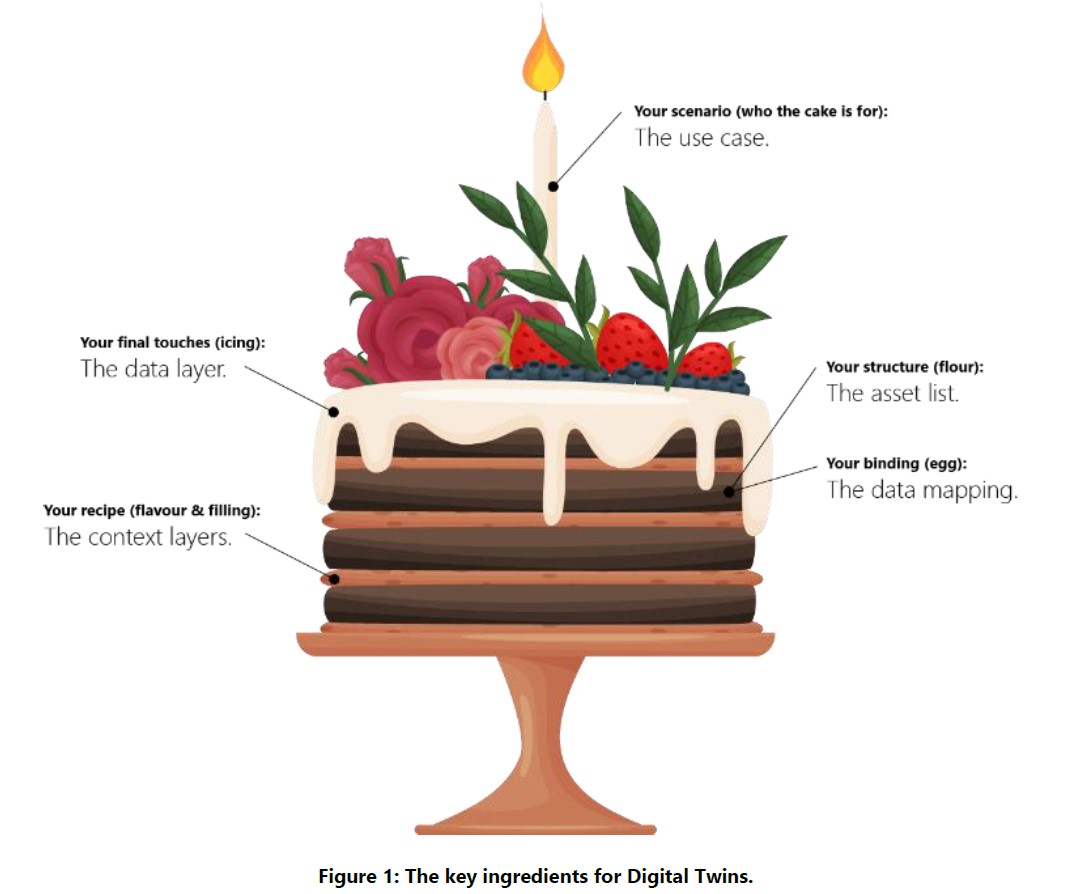March 25, 2025
The Perfect Recipe for Digital Twins
Recently a client asked me how one makes a digital twin.
The best analogy I've found so far is that it's like making a cake - you need to bring the right ingredients together, in the right way, for the right purpose.
Something I hear a lot in organisations, from manufacturing clients through to local government agencies, is "I keep hearing about digital twins. How do you really make one, and what value can it honestly bring to me?".
In my opinion, one of the major causes of this confusion is the proliferate use of the term "Digital Twin" across the market, leading many organisations to recoil from any mention of digital twins, having been burnt by a bad experience trying to implement them.
To help unpack this, I like to describe digital twins as being a bit like cake. It requires a number of things to come together correctly, in order to actually be a cake, and be a cake that you like. You can't just throw a packet of flour on a board and call it a cake, nor would you want to take a 3 year old's unicorn shaped birthday cake to a 50th wedding anniversary dinner. To avoid these missteps in your digital twin journey, I recommend going about creating your digital twin in the same way you would if you were making a cake.
So, first things first. Before you start your cake, even before you can find the right recipe, you need to consider the occasion and who the cake is for. Cakes for a wedding or a child’s birthday are two very different scenarios – they are essentially different use cases. If you don’t think carefully about your audience up front, you might end up with something that looks great but doesn’t speak to their needs and interests, and doesn’t do the job you need it to. In short: you first need to clearly identify and understand what your use case is, and use that to guide the entire process.
Once you know who you are making your cake for, you then need to consider flavor and fillings, and choose a recipe. This relates very specifically to the scenario your cake will appear in, and needs to cater to the tastes and interests of your audience. In the digital twin sense, the fillings and flavors include things like 3D models, point clouds, P&IDs, photography, photogrammetry, 2D and 3D maps, anything which provides immediate context for the rest of the solution.
Flavors and fillings on their own are not cake; but without them, a cake is just a weird kind of bread.
We call this the context layer, and depending on what flavor of cake you want, you can then choose which specific recipe will work best for you. For example, some people choose a recipe that has a different flavor in each layer, and I think that’s great.
On to ingredients. You need your flour of course. It’s simple, but if you don’t have it, you have nothing that the other ingredients of your cake can combine with to produce cake. For digital twins, this structure is provided by your asset list. An asset list could be as simple as an Excel spreadsheet or a direct API integration into SAP, but this creates an important structural element to your twin that everything else is based on.
Often under-rated ingredients are those used for binding: usually something like eggs or vegetable oil. In the case of digital twins, the eggs are the mappings for how all the data in the twin is connected. We have automated ways of providing this mapping, but if you don’t do this part correctly, you will not be successful in binding all your rich data to your structure and it won’t come together correctly - you’re going to be left with a pile of crumbs that nobody wants to eat.


Speaking of binding, mixing is the most important part of the recipe in my opinion. You need to simultaneously beat the ingredients to introduce air whilst not over-beating to turn it into solid rock. This requires some skill and a good repeatable process – you need to have a good chef. In the case of a digital twin, this involves linking your visualizations to your data, using your mappings and business rules so the system can rise on its own a deliver the most value: light, fluffy and moist.
When selecting what mixer to use, you could use a big industrial mixer, a small niche one, or you could use multiple mixers. There are many types of digital twin mixers available in the market, and selecting the right one can be the difference between a twin that people relish, and one they have an allergic reaction to.
This mixing can be done by hand, but as an experienced Digital Twin baker I usually recommend using a mixer which can also do automated mixing for the best consistency. It isn’t a digital twin in and of itself, but it automates and standardizes a lot of the baking process.
Once we have our cake baked, it’s time to turn our attention to the icing. For me, the icing is the data layer. The data, after all, is the reason your users come to your digital twin in the first place, and it needs to appeal to them, make sense, and be intuitive.
Importantly though, if all you did was provide them with data, they would just get a big oversweet blob of fattening icing. Now, I love both data and icing but even I can’t handle it just on its own. I need the structure of all the other ingredients which I can hang my data on.
Once the structure is in place you can embed your data, be it the static marzipan of asset information or the far more fluid buttercream of real time streaming information. The data is what people come to your twin for, and if this part is not right, they won’t even want to take the first bite.
Bringing all these elements together is what makes a digital twin, a twin. Following the right recipe, with the right chef, the right ingredients, and the right tools is what makes the difference between a cake that hits the spot, rather than, well, weird bread.
Get in touch today
For over 100 years, we have been helping transform our world. Today, we are on a mission to creatively solve the problems that matter; using our understanding of industries and assets, and the operating and engineering technologies that support those assets.Drawing on our rich engineering and project delivery heritage, we created BEYON: a digital twin platform for complex asset information, that enables you to use every resource wisely and deliver tangible business outcomes, every day. |
|
|
Stephen Witherden CTO & Co-founder BEYON Digital Twin +61 404 199123 stephen.witherden@beyon.global |
